MiniMEXLE Hodiny na orientačný beh: Rozdiel medzi revíziami
Zo stránky SensorWiki
| Riadok 109: | Riadok 109: | ||
<source lang="c"> | <source lang="c"> | ||
int | |||
/**************************************************************** | |||
File name - Zadanie_final.c | |||
Compiler - WinAVR / AVR GCC | |||
Author - David Lesko | |||
*****************************************************************/ | |||
#include<avr/io.h> | |||
#include<util/delay.h> | |||
#include"lcd.h" | |||
#include<avr/interrupt.h> | |||
#define SET_BIT(PORT,BIT) ((PORT)|=(1<<BIT)) | |||
#define CLR_BIT(PORT,BIT) ((PORT)&=~(1<<BIT)) | |||
#define ENABLE 7 | |||
#define PC_PORT PORTC | |||
#define PC_PIN1 0 | |||
#define PC_PIN2 1 | |||
#define bit(m) ((1<<m)) | |||
#define bit_get(p,m) ((p) & bit(m)) | |||
#define MIN_PER 100 | |||
#define MAX_PER 255 | |||
#define WAIT_TIME 2000 | |||
#define PIN(x) (*(&x - 2)) | |||
bool sw1 = 0; | |||
bool sw2 = 0; | |||
int s=0,secondss=0; | |||
static volatile seconds,minutes; | |||
void readButtons(void); // Nacitanie stavu tlacidiel | |||
void inkrement(void); // Inkrementacia sekundy | |||
void sekundy(void); // Seconds function | |||
void minuty(void); // Minutes function | |||
void short_beep(void); // Short beep function | |||
void long_beep(void); // Long beep function | |||
void short_beep(void) | |||
{ | |||
int i=0; | |||
for(i=0;i<=800;i++) | |||
{ | |||
PORTD |= 0x20; | |||
_delay_us(300); | |||
PORTD &= 0xDF; | |||
_delay_us(300); | |||
} | |||
} | |||
ISR(TIMER1_COMPA_vect) | |||
{ | |||
inkrement(); | |||
} | |||
void inkrement(void) | |||
{ | |||
if(seconds!=60) | |||
{ | |||
seconds++; | |||
} | |||
else | |||
{ | |||
minutes++; | |||
seconds = 0; | |||
} | |||
TCNT1=0; // Reset TIMER1 | |||
} | |||
void sekundy(void) | |||
{ | |||
switch(seconds) | |||
{ | |||
case 0: | |||
lcd_gotoxy(1,14); | |||
lcd_putstr(" "); | |||
break; | |||
case 3: | |||
short_beep(); | |||
break; | |||
case 55: | |||
lcd_gotoxy(1,14); | |||
lcd_putstr("55"); | |||
break; | |||
case 56: | |||
lcd_gotoxy(1,14); | |||
lcd_putstr("56"); | |||
break; | |||
case 57: | |||
lcd_gotoxy(1,14); | |||
lcd_putstr("57"); | |||
break; | |||
case 58: | |||
lcd_gotoxy(1,14); | |||
lcd_putstr("58"); | |||
break; | |||
case 59: | |||
lcd_gotoxy(1,14); | |||
lcd_putstr("59"); | |||
break; | |||
} | |||
} | |||
void minuty(void) | |||
{ | |||
switch(minutes) | |||
{ | |||
case 0: | |||
lcd_gotoxy(1,9); | |||
lcd_putstr("00"); | |||
break; | |||
case 1: | |||
lcd_gotoxy(1,9); | |||
lcd_putstr("01"); | |||
break; | |||
case 2: | |||
lcd_gotoxy(1,9); | |||
lcd_putstr("02"); | |||
break; | |||
case 3: | |||
lcd_gotoxy(1,9); | |||
lcd_putstr("03"); | |||
break; | |||
case 4: | |||
lcd_gotoxy(1,9); | |||
lcd_putstr("04"); | |||
break; | |||
case 5: | |||
lcd_gotoxy(1,9); | |||
lcd_putstr("05"); | |||
break; | |||
case 6: | |||
lcd_gotoxy(1,9); | |||
lcd_putstr("06"); | |||
break; | |||
case 7: | |||
lcd_gotoxy(1,9); | |||
lcd_putstr("07"); | |||
break; | |||
case 8: | |||
lcd_gotoxy(1,9); | |||
lcd_putstr("08"); | |||
break; | |||
} | |||
} | |||
void readButtons(void) | |||
{ | |||
CLR_BIT(PORTD,ENABLE); | |||
DDRC = DDRC & 0xf0; | |||
PORTC = 0x0f; | |||
_delay_us(10); | |||
sw1 = !bit_get(PIN(PC_PORT),PC_PIN1); | |||
_delay_ms(10); | |||
sw2 = !bit_get(PIN(PC_PORT),PC_PIN2); | |||
_delay_ms(10); | |||
DDRC = DDRC|0x0f; | |||
} | } | ||
int main() | |||
{ | |||
int tl=0; | |||
lcd_init(); // Inicializacia displeja | |||
LCD_initialise(); | |||
lcd_gotoxy(1,9); | |||
lcd_putstr("--"); | |||
DDRD |= (1<<DDD5); // Initialisation of Buzzer | |||
TCCR1A = 0; // Normal Mode Timer1 | |||
TCCR1B = (1<<CS12)|(1<<CS10); // Prescaler 1024 | |||
TCNT1 = 0; // Start count from 0 | |||
OCR1A = 15625; // 1 second | |||
TIFR1 = (1<<OCF1A); // Clear Pending Interrupt | |||
TIMSK1 = 0; // Disable Compare A Interrupt | |||
sei(); | |||
while(1) // loop forever | |||
{ | |||
lcd_gotoxy(0,0); | |||
lcd_putstr(" O"); | |||
readButtons(); | |||
if(sw1 && tl==0){ | |||
tl=1; // Osetrenie zdvojeneho stlacenia SW1 | |||
TCNT1 = 0; | |||
TIMSK1 = (1<<OCIE1A); // Enable Compare A Interrupt | |||
} | |||
else if(sw2 && tl==1) | |||
{ | |||
lcd_gotoxy(1,9); | |||
lcd_putstr("--"); | |||
tl=0; // Osetrenie zdvojeneho stlacenia SW2 | |||
TCNT1 = 0; // Reset Timer | |||
TIMSK1 = 0; // Disable Compare A Interrupt | |||
seconds = 0; // Reset sekund | |||
minutes = 0; // Reset minut | |||
sekundy(); | |||
} | |||
else if(tl==1) | |||
{ | |||
sekundy(); | |||
minuty(); | |||
} | |||
} | |||
} | |||
</source> | </source> | ||
Verzia z 21:24, 10. január 2014
| Autori: | Bc.Dávid Leško, Bc.Vladimír Biath | |
| Študijný odbor: | Aplikovaná mechatronika | 2. Ing. (2013) |
Zadanie
LCD displej na doske MiniMEXLE treba pripojiť k mikroprocesoru a naprogramovať tak, aby po zapnutí odpočítaval minúty nasledujúce po štarte, pričom posledných 5 sekúnd pred každou celou minútou odpípa. Posledné pípnutie bude dlhšie a bude sprevádzané inkrementovaním čísla na displeji. Pred časom 00 bude displej zobrazovať pripravenosť symbolmi --.
K zapojeniu treba vypracovať dokumentáciu, popis programu, schému zapojenia displeja a riadiacej jednotky. Ako bonus doplňte riadenie intenzity displeja na základe vonkajšieho osvetlenia.
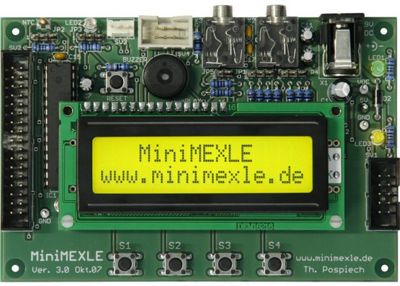
Literatúra:
- Dokumentácia k doske MiniMexle
- http://virtuallab.kar.fei.stuba.sk/robowiki/images/d/da/MiniMexle_manual.pdf
- http://www.robotika.sk/holls/2008/doc/Gruhler2008_IntroductionMEXLE.pdf
- http://ap.urpi.fei.stuba.sk/sensorwiki/index.php/S%C3%BAbor:MiniMexleBlockDiagram.png
- http://ap.urpi.fei.stuba.sk/sensorwiki/index.php/S%C3%BAbor:Schemazapojenia.jpg
- http://www.display-elektronik.de/DEM16216SYH-LY.PDF
Analýza - hardware
MiniMexle:
- Microcontroller ATmega48/88 (pre naše riešenie sme použili Microcontroller ATmega328P programované cez USB rozhranie)
- Display DEM16216, 2x16 LCD-Display,
- 4 push buttons
- Analógové rozhranie : 2 A/D a 2 D/A kanály
Hardware MiniMexle:
Na obrázku nižšie sú označené jednotlivé prvky dosky MiniMexle:
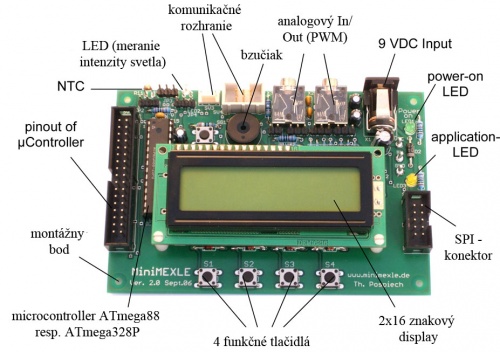
- odkaz na schemu | zapojenia
Display:
Na zobrazovanie odpočítavania času sme použili display s označením DEM16216, ktorý pozostáva z 2 x 16 znakového displeja.
- 16 pin konektor pre pripojenie k doske MiniMexle

Write mode Display16216:

Read mode Display16216:

- bližšie informácie k displeju viď literatúra
Popis riešenia
Bloková schéma
- blokova schema dosky MiniMexle
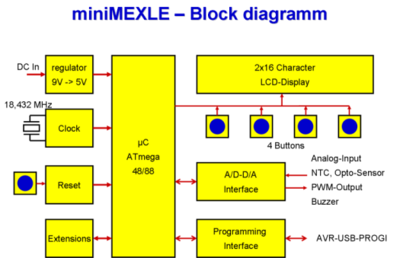
Užívateľské rozhranie:
- x16 LCD displej s podsvietením
(Spojený 4 bity)
(RS: Data / Control)
(E = 1: Enable Display)
(R premenná: Kontrast)
- 4 tlačidlá pripojená na rovnaké piny ako LCD displej
(E = 0: Read buttons)
(Port μC obojsmerný)
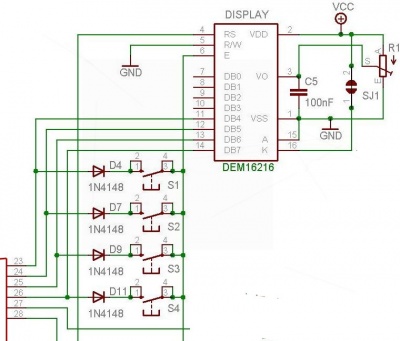
Programovateľné rozhranie
- SPI Interface
(Serial Peripheral Interface) to programmer (PROGI)
(programming active for RESET = 0)
- Visual interface by LED3
- SPI signal names:
MISO = Master IN, Slave OUT
MOSI = Master OUT, Slave IN
SCLK = Serial Clock
SS = Slave Select
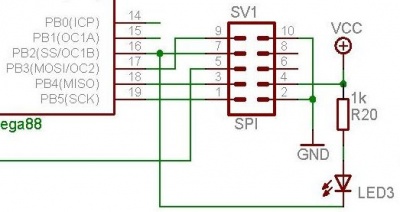
Algoritmus a program
Uveďte stručný popis algoritmu, v akom jazyku a verzii vývojového prostredia ste ho vytvorili. Je vhodné nakresliť aspoň hrubú štruktúru programu napríklad vo forme vývojového diagramu. Rozsiahly program pre lepšiu prehľadnosť rozdeľte do viacerých súborov.
Vyberte podstatné časti zdrojového kódu, použite na to prostredie source:
/****************************************************************
File name - Zadanie_final.c
Compiler - WinAVR / AVR GCC
Author - David Lesko
*****************************************************************/
#include<avr/io.h>
#include<util/delay.h>
#include"lcd.h"
#include<avr/interrupt.h>
#define SET_BIT(PORT,BIT) ((PORT)|=(1<<BIT))
#define CLR_BIT(PORT,BIT) ((PORT)&=~(1<<BIT))
#define ENABLE 7
#define PC_PORT PORTC
#define PC_PIN1 0
#define PC_PIN2 1
#define bit(m) ((1<<m))
#define bit_get(p,m) ((p) & bit(m))
#define MIN_PER 100
#define MAX_PER 255
#define WAIT_TIME 2000
#define PIN(x) (*(&x - 2))
bool sw1 = 0;
bool sw2 = 0;
int s=0,secondss=0;
static volatile seconds,minutes;
void readButtons(void); // Nacitanie stavu tlacidiel
void inkrement(void); // Inkrementacia sekundy
void sekundy(void); // Seconds function
void minuty(void); // Minutes function
void short_beep(void); // Short beep function
void long_beep(void); // Long beep function
void short_beep(void)
{
int i=0;
for(i=0;i<=800;i++)
{
PORTD |= 0x20;
_delay_us(300);
PORTD &= 0xDF;
_delay_us(300);
}
}
ISR(TIMER1_COMPA_vect)
{
inkrement();
}
void inkrement(void)
{
if(seconds!=60)
{
seconds++;
}
else
{
minutes++;
seconds = 0;
}
TCNT1=0; // Reset TIMER1
}
void sekundy(void)
{
switch(seconds)
{
case 0:
lcd_gotoxy(1,14);
lcd_putstr(" ");
break;
case 3:
short_beep();
break;
case 55:
lcd_gotoxy(1,14);
lcd_putstr("55");
break;
case 56:
lcd_gotoxy(1,14);
lcd_putstr("56");
break;
case 57:
lcd_gotoxy(1,14);
lcd_putstr("57");
break;
case 58:
lcd_gotoxy(1,14);
lcd_putstr("58");
break;
case 59:
lcd_gotoxy(1,14);
lcd_putstr("59");
break;
}
}
void minuty(void)
{
switch(minutes)
{
case 0:
lcd_gotoxy(1,9);
lcd_putstr("00");
break;
case 1:
lcd_gotoxy(1,9);
lcd_putstr("01");
break;
case 2:
lcd_gotoxy(1,9);
lcd_putstr("02");
break;
case 3:
lcd_gotoxy(1,9);
lcd_putstr("03");
break;
case 4:
lcd_gotoxy(1,9);
lcd_putstr("04");
break;
case 5:
lcd_gotoxy(1,9);
lcd_putstr("05");
break;
case 6:
lcd_gotoxy(1,9);
lcd_putstr("06");
break;
case 7:
lcd_gotoxy(1,9);
lcd_putstr("07");
break;
case 8:
lcd_gotoxy(1,9);
lcd_putstr("08");
break;
}
}
void readButtons(void)
{
CLR_BIT(PORTD,ENABLE);
DDRC = DDRC & 0xf0;
PORTC = 0x0f;
_delay_us(10);
sw1 = !bit_get(PIN(PC_PORT),PC_PIN1);
_delay_ms(10);
sw2 = !bit_get(PIN(PC_PORT),PC_PIN2);
_delay_ms(10);
DDRC = DDRC|0x0f;
}
int main()
{
int tl=0;
lcd_init(); // Inicializacia displeja
LCD_initialise();
lcd_gotoxy(1,9);
lcd_putstr("--");
DDRD |= (1<<DDD5); // Initialisation of Buzzer
TCCR1A = 0; // Normal Mode Timer1
TCCR1B = (1<<CS12)|(1<<CS10); // Prescaler 1024
TCNT1 = 0; // Start count from 0
OCR1A = 15625; // 1 second
TIFR1 = (1<<OCF1A); // Clear Pending Interrupt
TIMSK1 = 0; // Disable Compare A Interrupt
sei();
while(1) // loop forever
{
lcd_gotoxy(0,0);
lcd_putstr(" O");
readButtons();
if(sw1 && tl==0){
tl=1; // Osetrenie zdvojeneho stlacenia SW1
TCNT1 = 0;
TIMSK1 = (1<<OCIE1A); // Enable Compare A Interrupt
}
else if(sw2 && tl==1)
{
lcd_gotoxy(1,9);
lcd_putstr("--");
tl=0; // Osetrenie zdvojeneho stlacenia SW2
TCNT1 = 0; // Reset Timer
TIMSK1 = 0; // Disable Compare A Interrupt
seconds = 0; // Reset sekund
minutes = 0; // Reset minut
sekundy();
}
else if(tl==1)
{
sekundy();
minuty();
}
}
}
Nezabudnite však nahrať aj kompletné zdrojové kódy vášho programu!
Zdrojový kód: serial.h a main.c
Overenie
Nezabudnite napísať čosi ako užívateľský návod. Z neho by malo byť jasné čo program robí, ako sa prejavuje a aké má užívateľské rozhranie (čo treba stlačiť, čo sa kde zobrazuje). Ak ste namerali nejaké signály, sem s nimi. Ak je výsledkom nejaký údaj na displeji, odfotografujte ho.
Kľúčové slová 'Category', ktoré sú na konci stránky nemeňte.